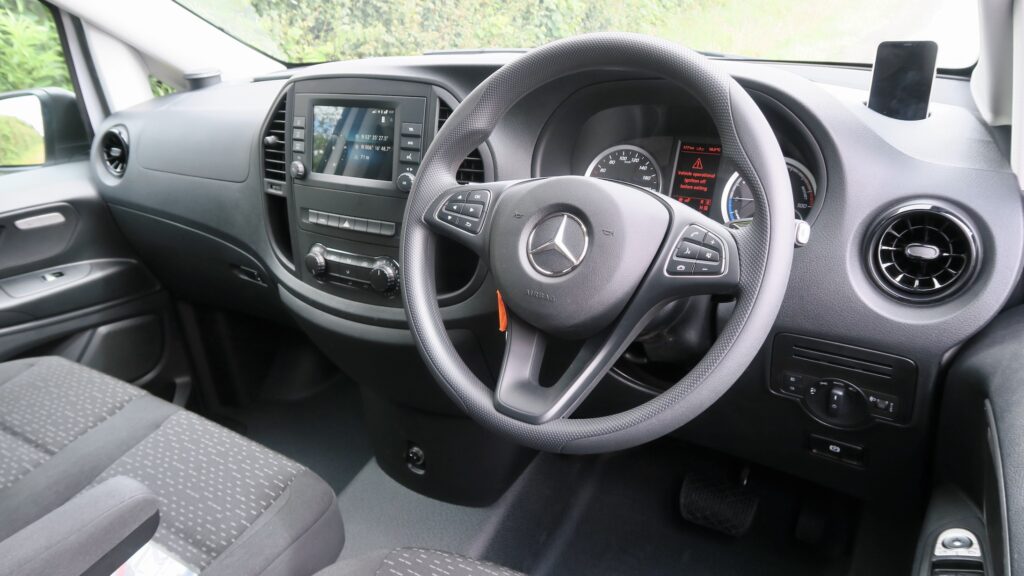05/08/2022 Electric vans are an essential part of the drive to reduce emissions – they’re also really nice to drive. The elephant in the room is their ability to deliver on promised range when used in the real world. If you buy the wrong van it is no laughing matter as your livelihood is directly affected. EV vans are great for urban use where there is access to overnight charging but for rural use range becomes a serious issue. We’ve taken the eVito for a brief test.

The eVito has been given a makeover and the promise of 70% more range from a full charge. The front wheel drive light commercial vehicle gets a 66kWh battery (60kWh net) that can return up to 314km. There is a CCS (combo AC/DC) charge socket on the passenger side of the front bumper so you charge nose-in at fast chargers. The standard onboard charger can take up to 7.4kW AC (the max power a normal house can deliver) and will take 6.5 hours to charge fully. A faster 11kW charger is a cost option. The DC socket can take a charge up to 50kW – so no need to pay over the odds at the likes of an Ionity rapid charger – the public fast chargers can deliver up to 50kW through their CCS cable and here a 10-80% charge takes 50 minutes. (An 80kW capacity is an optional extra). During a 119km data (supplied by Mercedes-Benz to us post test drive) confirmed we averaged 12.6kWh per 100km fuel consumption on a route that that included some brief motorway work among a mix of urban and rural roads. We recuperated 1.2kWh/100km over a total time period of 2 hours 28 minutes. Our drive cost circa €3 in our electric van compared to circa €12 for a diesel.

The electric motor pushes out 114hp and up to 300-360nm of torque – comparable to the Vito 111 diesel. Performance in our unladen test car was acceptable but with its heavy feeling accelerator pedal you never felt an urge to accelerate hard. The eVito feels weighty when empty but as the weight is so low net below the cargo deck the van feels solid and handles twisty routes quite well. As with all EVs the driving process is effortless and relaxing compared to a diesel. Simply select D on the right hand steering stalk and off you go.

There is a brake hold feature, that simply requires a firm press on the brake when stationary to activate, that makes stop start driving stress free. The turning circle is good and the suspension delivers a smooth ride. Selectable driving modes are available with E+, E and C. Various levels of regenerative braking feature. The amount of braking can be adjusted using the steering wheel mounted paddle shifters. On the driver’s display you can see the selected force with ‘D-‘ the strongest, D offering a standard amount, D+ feels like your coasting and D++ is frees like you’re free wheeling with a bit of a tailwind. So D or D- of urban use and use the ++ on the open road where braking is seldom required.

The cabin is bleak and functional with familiar switchgear that is tried and tested. The one plus two three-seat cabin is comfortable and there the driver’s seat has a good range of adjustment and legroom despite its full height bulkhead. The cargo area has good access and the floor is a nice height for loading a tools.

eVito is just shy of 2m tall so it is carpark friendly. Two body lengths are available: an A2 (5,140mm) and A3 at 5,370mm. Cargo volume is 6m3 and 6.6m3 respectfully. The eVito is heavy starting at 2,412kgs and with a GVWR figure of 3,200kgs this is reflected in its payload at 807kgs in the standard A2 and 772kgs in the 2,477kgs A3. The battery pack is guaranteed for 8 years of 160,000km. Opting for the new eVito is less of a critical choice thanks to its improved range. For fleet buyers going electric is a no brainer as companies simply have to go EV to reduce their carbon footprint and avoid customer criticism. Total cost of ownership is the key to a wise purchase and Mercedes offers an ‘eCost’ calculator to help potential buyers do the maths. The LWB eVito has a retail price of €56,999 (€46,178 + VAT €10,620.94 + VRT €200) that brings it in just under the €60K SEAI grants threshold. Diesel isn’t dead but the transport world is changing rapidly and the eVito is a fine example of this trend. Michael Sheridan




